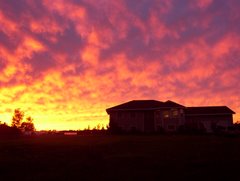Here a photo to check horn placement:

... and body conformation (he's very square and very stocky ... and also too fat since he's first in and last out of the creep!).

Here's a hindquarter shot ... for examining "leg of lamb" characteristics and leg conformation. Shetlands tend to be cow-hocked, where the point of hock point in toward each other. His grandmother Billie Holiday was very bad, Kivu better and with this generation we've managed a good straight leg. The other thing that is important to watch for is tail-set. Shetlands are a short-tail breed, meaning that their tails are shorter and are not fleece covered. They should be naturally fluke-shaped (wide at the top, narrow at the bottom). Regular market-type fleece breeds have long fleece-covered tails. These MUST be docked, because as the fleece grows out on the tail it causes serious hygiene problems and can set the animal up for something called "fly strike".

An underside shot so Bill can help me identify his colour/pattern. He's likely a black tisket gulmoget, also known as a Canadian gulmoget, however Bill will want to confirm that.

And lastly, a fleece shot ... very, very difficult to photograph black fleece with my little camera. I'm hoping that when this page is published, I can click on the photograph and see a bit better.




No comments:
Post a Comment